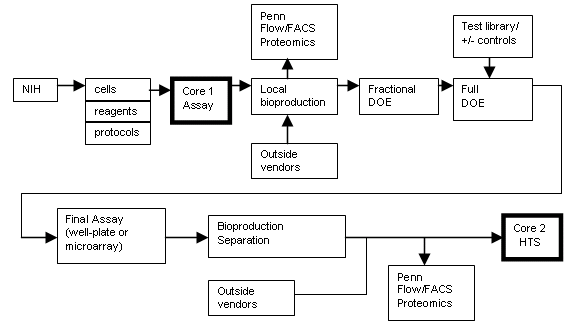

Homogeneous and separation-free well plate biochemical assay platforms include proximity-based assays such as scintillation proximity assay (SPA), LOCI (luminescent oxygen channeling assay (i.e. alpha-screen), and fluorescent resonance energy transfer, FRET). FRET has advanced with time-resolved fluorescence (TRF) instruments to read the long-lived cryptate lanthanides (Eu, Tb) to resolve specific energy transfer signal above nonspecific autofluorescence.
Fluorescence polarization (FP) anisotropy is valuable for detection of enzymatic or binding reactions that result in a change in molecular weight of small fluorescent reactants with consequent change in rotational diffusivity. To list only a few examples, kinase HTS assays can involve: (1) fluorescent binders or quenchers to fluorescent phosphorylated substrates {e.g. anti-phosphotyrosine antibodies, fluorescent PDZ domains, IQ, and IMAP reagents}, (2) protease treatment of quenched peptide detector whose cleavage is blocked by phosphorylation (e.g. Z-lyte assay), (3) FP detection of binders to phosphorylated peptides, (4) detection of phosphorylated iodinated-peptides captured on anti-phosphotyrosine-SPA beads, (5) phophopeptide mediated aggregation of alpha-screen beads coated with anti-phosphotyrosine, or (6) luciferase or enzyme amplification assay of ATP consumption. These formats have reduced cost and complexity beyond the classic radioisotope assay of capture of P32 or P33-labeled phosphorylated peptides, and top-count reading of washed 384-well plates or use of FlashPlate scintillation. Detection of direct compound binding to protein targets have relied upon plasmon resonance, thermal denaturation profiling, or capture of fluorescent protein targets to anchored phamacophores. Cell based assays often involved the detection of: marker gene (gfp, luc, beta-gal) induction, calcium mobilization, dye binding to activated membranes, rubidium efflux, or cell killing/lysis assays for the discovery of anticancer agents, anti-apoptotic agents, anti-microbial agents. Imaging based assays of intracellular fluorescence localization has proven powerful for analysis of nuclear localization of hormone receptors. High throughput ion channel recording remains a challenging area despite gains in nanofabricated surfaces for cell recording. Cellular assays can often enhance the discovery opportunity for compounds that are cell permeable and non-toxic. Protease assays typically involve fluorogenic peptides that have coumarin leaving groups. Alternatively, quenched peptides can be designed that dequench when cleaved.
|

